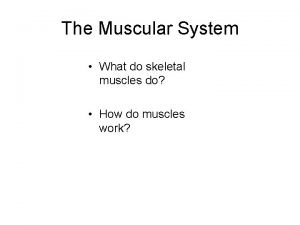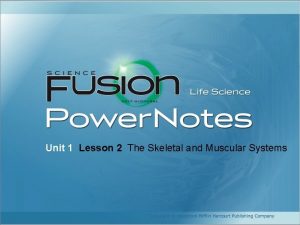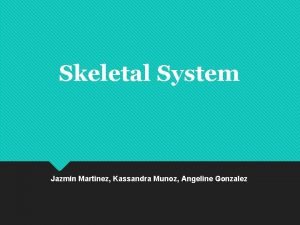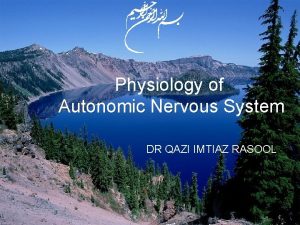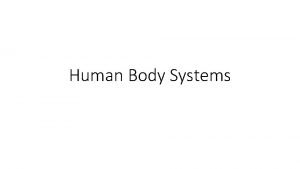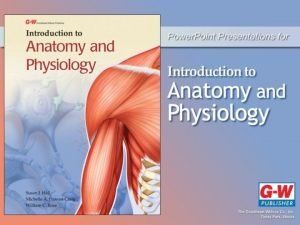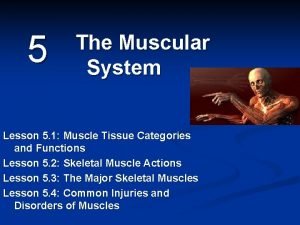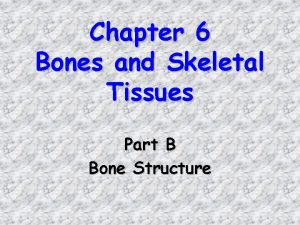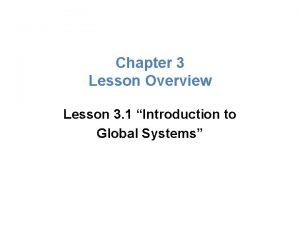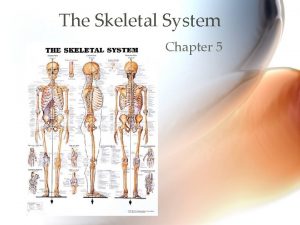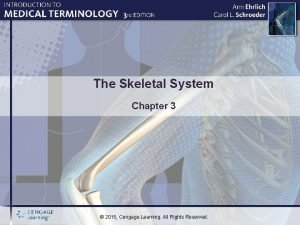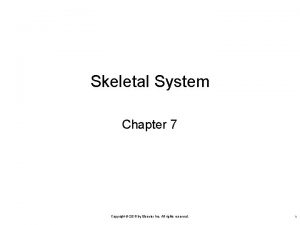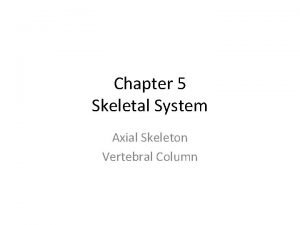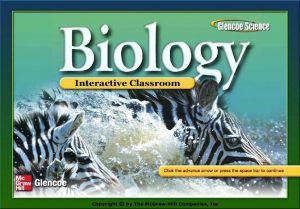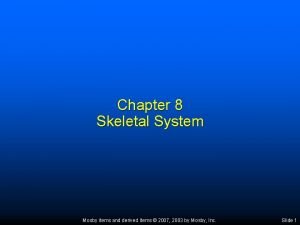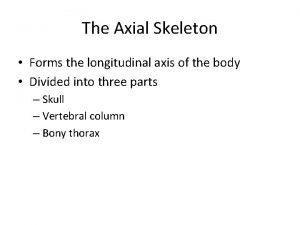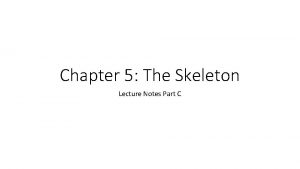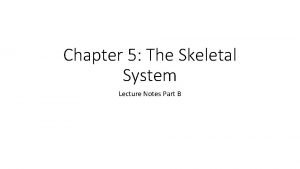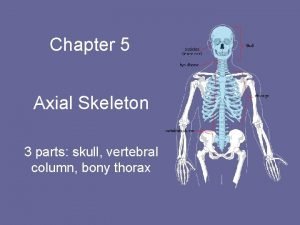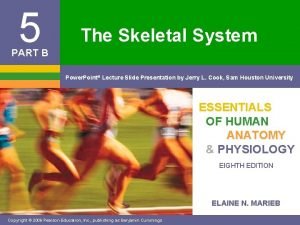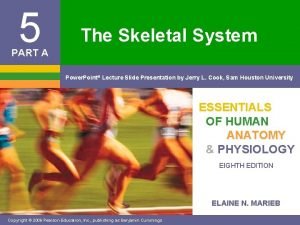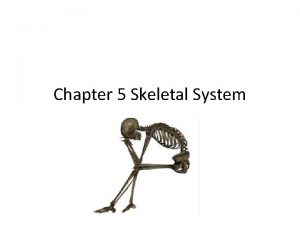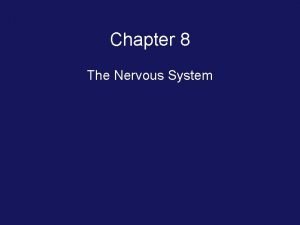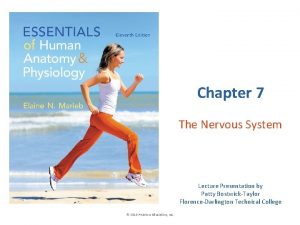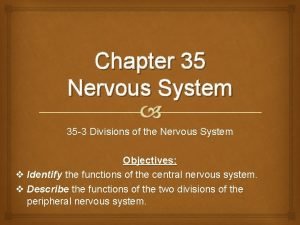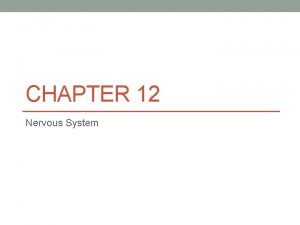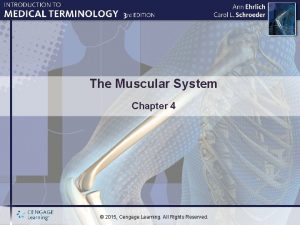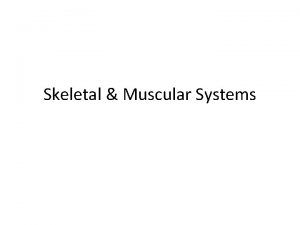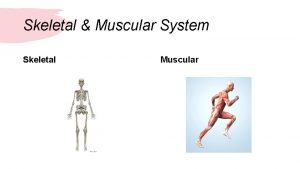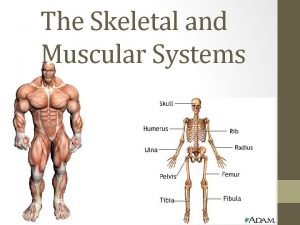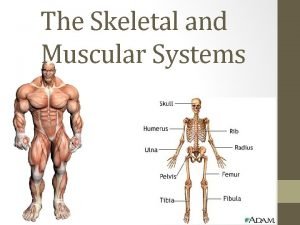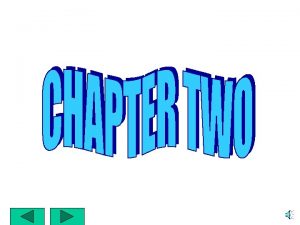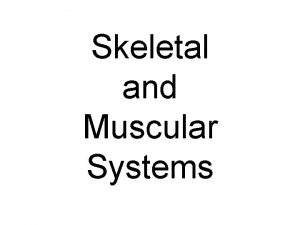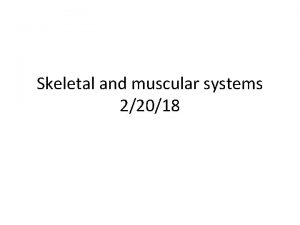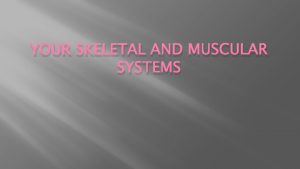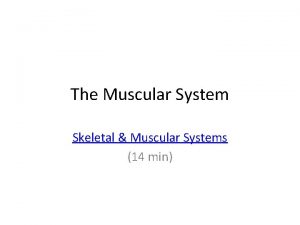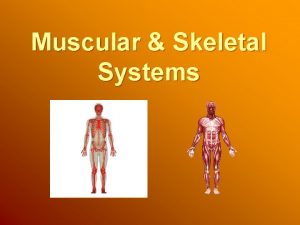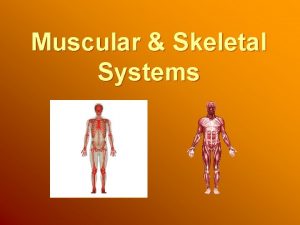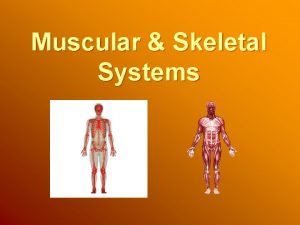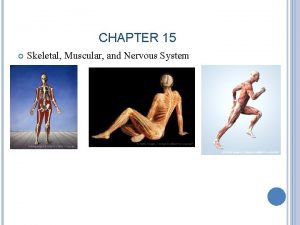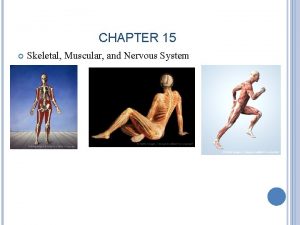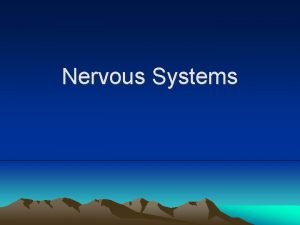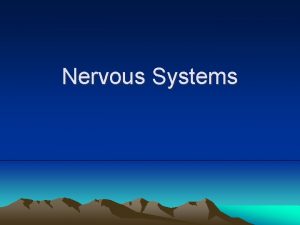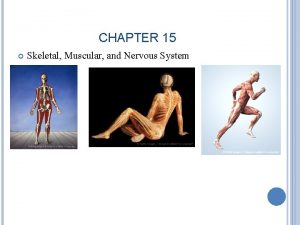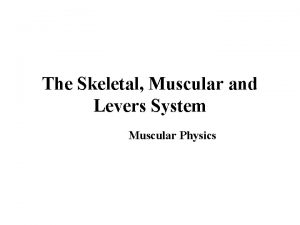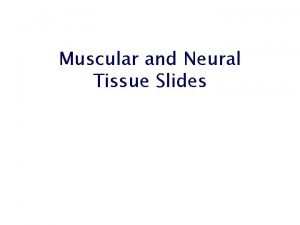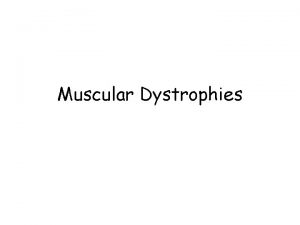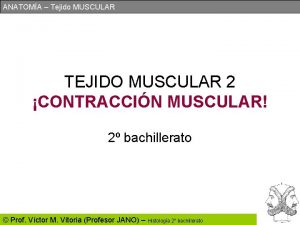CHAPTER 14 Skeletal Muscular and Nervous Systems Lesson














































- Slides: 46

CHAPTER 14 Skeletal, Muscular, and Nervous Systems

Lesson 1 The Skeletal System

HOW THE SKELETAL SYSTEM WORKS Skeletal system consists of 206 bones Tiniest bones are in the inner ear Longest bone in the body is your thigh bone

FUNCTIONS OF THE SKELETAL SYSTEM Providing support for the body Protecting internal tissues and organs from damage Acting as a framework for attached muscles Allowing movement of limbs and digits Producing new red and white blood cells Storing fat and minerals, such as calcium and phosphorus

BONES STANDARD 4. 2 Bones are made up of living tissues formed into different layers The outer layer is hard, densely packed, compact bone Beneath the outer layer is spongy bone, a less dense bone with a network of cavities filled with red bone marrow (where blood cells are produced) Some bones also contain yellow bone marrow—a type of connective tissue that stores fat They are categorized by their shape Shapes include long bones, short bones, flat bones, and irregular bones

BONES


ARM BONES

LEG BONES

CONNECTIVE TISSUE STANDARD 4. 2 3 types of connective tissue Cartilage- a strong flexible connective tissue that can act as a cushion between two bones to reduce friction Can also act as a flexible structure for soft parts of the body (tip of the nose or the outer ear) Ossification-is the process by which bone is formed, renewed, and repaired Ligament- a band of fibrous, slightly elastic connective tissue that attaches one bone to another Tendon-a fibrous cord that attaches muscle to the bone

JOINTS STANDARD 4. 2 Joints- are points at which bones meet Joints like the ones between the bones of the skull do not move Flexible joints: Ball-and-socket joints- a joint in which the ball-shaped surface of one rounded bone fits into the cup like depression of another bone Hinge joints- a joint in which a curved part of one bone fits into a bowl-shaped part of another, allowing motion in only one plane Pivot joints- a joint in which the ends of two bones meet—one end being a central bony cylinder, the other end being a ring Ellipsoidal joints- the site of junction or union between bones, especially one that allows motion of the bones


UNDERSTANDING SKELETAL PROBLEMS STANDARD 4. 2 Fractures- any type of break in a bone Compound fracture-the broken end of the bone breaks through the skin Simple fracture- the broken bone does not break through the skin Classifications of fractures Hairline fracture- if parts of the bone do not separate Transverse fracture- when the fracture is completely across the bone Comminuted fractures- when a bone shatters into more that two pieces

SIMPLE AND COMPOUND FRACTURES

CLASSIFICATIONS OF FRACTURES Hairline Fracture Transverse Fracture Comminuted


UNDERSTANDING SKELETAL PROBLEMS Injuries to Joints Dislocation- when a bone slips out of place, tearing the ligaments that attach the bone at the joint Torn cartilage-results from a sharp blow to a joint or a severe twisting of a joint. Bursitis- results from the painful inflammation of bursa, a fluid-filled sac that helps reduce friction in joints Bunions- are painful swellings of the bursae in the first joints of big toes. Arthritis- the inflammation of a joint, resulting from an injury, natural wear and tear, or autoimmune disease

INJURIES TO JOINTS Dislocation Cartilage Torn

INJURIES TO JOINTS Bursitis Bunions Arthritis

UNDERSTANDING SKELETAL PROBLEMS STANDARD 4. 2 Repetitive Motion Injury- prolonged, repeated movements that can damage tissues Carpal tunnel syndrome-occurs when ligaments and tendons in the wrist swell, causing numbness, a tingling sensation in the thumb and forefinger, pain, and weakness in the hand Osteoporosis- a condition in which there is a progressive loss of bone tissue

Lesson 2 The Muscular System

HOW MUSCLES WORK STANDARD 4. 2 Muscle- made up of hundreds of long cells called muscle fibers Major muscles in the body are made up of hundreds of bundles of these fibers When the bundles are stimulated by nerve impulses, or signals, they contract, or shorten. When they relax, the bundles extend, or stretch

MUSCULAR SYSTEM

TYPES OF MUSCLES STANDARD 4. 2 Smooth muscles- muscles that act on the lining of the body’s passageways and hollow internal organs. Can be found in the digestive tract, the urinary bladder, the lining of the blood vessels and the passageways that lead into the lungs They are involuntary muscles Cardiac Muscle-a type of striated muscle that forms the wall of the heart Involuntary muscles The heart contracts rhythmically about 100, 000 times each day to pump blood throughout you body

TYPES OF MUSCLES STANDARD 4. 2 Skeletal muscles- muscles attached to bone that cause body movements Skeletal muscle tissue has a striated, or striped, appearance under a microscope Most of your muscle tissue is skeletal Voluntary Muscles Flexor- the muscle that closes a joint Extensor- the muscle that opens a joint

TYPES OF MUSCLES

UNDERSTANDING MUSCULAR PROBLEMS Bruises-areas of discolored skin that appear after an injury, usually a blow to the body The injury causes the blood vessels beneath the skin to rupture and leak Muscles strains or sprains- when muscles are stretched or partially torn from overexertion Tendinitis- the inflammation of a tendon Hernia- when an organ or tissue protrudes through an area of weak muscle Muscular dystrophy- an inherited disorder in which skeletal muscle fibers are progressively destroyed

UNDERSTANDING MUSCULAR PROBLEMS Bruises Tendinitis Muscle Strain

UNDERSTANDING MUSCULAR PROBLEMS Hernia Muscular Dystrophy

Lesson 3 The Nervous System

HOW THE NERVOUS SYSTEM WORKS The brain, spinal cord, and nerves work together, transmitting messages between organs, tissues, and cells The nervous system has 2 main divisions: The central nervous system (CNS)- consists of the brain and spinal cord The peripheral nervous system (PNS) gathers information from inside and outside your body The CNS receives messages from the nerves in the PNS, interprets them, and sends out a response

UNDERSTANDING NEURONS Neurons- nerve cells, transmit messages to and from the spinal cord and brain. 3 types of Neurons Sensory Neurons-carry messages from receptors in the body to the CNS Motor Neurons-carry messages from the CNS back to muscles or glands in response to an impulse Interneurons-communicate with and connect other neurons

UNDERSTANDING NEURONS 3 main parts of a Neuron Cell body contains the nucleus, which regulates the production of proteins within the cell Neurons have limited ability to repair damage or replace destroyed cells Dendrites are branched structures that extend from the cell body in most neurons Receive information and transmit impulses toward the cell body Axons transmit impules away from the cell body and toward another neuron, muscle cell, or gland

THE CENTRAL NERVOUS SYSTEM 2 organs make up the CNS—the brain and spinal cord Send and receive impulses to and from nerves in the body The spinal cord: Long column of nerve tissue about the thickness of your index finger Tissue of the spinal cord is surrounded by several layers of connective tissue called the spinal meninges The meninges and the vertebrae—the bones of the spine—help protect the spinal cord Spinal cord is bathed in cerebrospinal fluid that absorbs shock and nourishes the nerve tissue

THE CENTRAL NERVOUS SYSTEM The Brain The adult brain weighs up to 3 pounds It is protected from injury by layers of cranial meninges and cerebrospinal fluid Depends on oxygen to survive Can last only 4 -5 minutes without oxygen before suffering irreversible damage

SECTIONS OF THE BRAIN The brain coordinates and control the activities of the nervous system Helps you to receive and process messages; to think, remember, reason, and feel emotions, and to coordinate muscle movements The brain has 3 main divisions: The cerebrum The cerebellum The brain stem

SECTIONS OF THE BRAIN The Cerebrum: is the largest and most complex part of the brain The left & right hemispheres communicate with each other to coordinate movement The right hemisphere controls the left side of the body Center for processing music and art and comprehending spatial relationships The left hemisphere controls the right side of the body The center of language, reasoning, and critical thinking skills

SECTIONS OF THE BRAIN The Cerebrum: The left and right hemispheres each have 4 lobes: The frontal lobe controls voluntary movements and has a role in the use of language The parietal lobe is involved with sensory information, including feelings of heat, cold, pain, touch, and body position in space The occipital lobe controls the sense of sight The temporal lobe contains the sense of hearing and smell, as well as memory, thought, and judgment

SECTIONS OF THE BRAIN The Cerebellum: is the second largest part of the brain Coordinates the movement of skeletal muscles Continually receives messages from sensory neurons in the inner ear and muscles Maintains the body’s posture and balance

SECTIONS OF THE BRAIN The Brain Stem: a 3 -inch-long stalk of nerve cells and fibers that connects the spinal cord to the rest of the brain 5 parts of the Brain Stem: The medulla oblongata regulates heartbeat, respiratory rate, and reflexes such as coughing and sneezing The pons helps regulate breathing and controls the muscles of the eyes and face The midbrain controls the eyeball movement, pupil size, and the reflexive response of turning your head

SECTIONS OF THE BRAIN The Brain Stem: 5 Parts of the Brain Stem: The thalamus relays incoming sensory impulses from the eyes, the ears, and from pressure receptors in the skin The hypothalamus regulates body temperature, appetite, sleep, and controls secretions from the pituitary gland, affecting metabolism, sexual development, and emotions

THE PERIPHERAL NERVOUS SYSTEM The peripheral nervous system (PNS) carries messages between the CNS and part of the body, signaling internal and external changes Made up of : the autonomic nervous system- controls such involuntary functions as digestion and heart rate Consists of a network of nerves divided into two smaller networks: the sympathetic nervous system and the parasympathetic nervous system the somatic nervous system- involves voluntary responses that are under your control Sensory neurons relay messages from the eyes, ears, nose, tongue, and skin to the CNS

THE PERIPHERAL NERVOUS SYSTEM The Autonomic Nervous System The sympathetic nervous system kicks in when you are startled, sending messages that cause your heart rate to increase Blood vessels in your muscles dilate, allowing greater blood flow. “Flight-or-fight” response The parasympathetic nervous system opposes the action of the sympathetic nervous system by slowing body functions. It slows heartbeat, relaxes blood vessels, and lowers blood pressure to conserve energy Stimulates production of saliva and stomach secretions to promote the digestion of food

PROBLEMS OF THE NERVOUS SYSTEM Headaches. Caused by muscle tension, eyestrain, exposure to fumes, a sinus infection, dehydration, or food allergies Migraines are recurrent headaches that may be accompanied by sensitivity to light Head injuries. Types of head injuries include concussion, a temporary loss of consciousness, contusion, a bruising of the brain tissues that causes swelling, and coma, caused by major trauma Spinal Injuries. Swelling of spinal cord or the tissue around it can result in temporary loss of nerve function. Permanent damage will result without treatment.

PROBLEMS OF THE NERVOUS SYSTEM Meningitis is an inflammation of the spinal and cranial meninges caused by bacterial or viral infection It is very serious and can result in death Symptoms include fever, headache, light and sound sensitivity, and neck stiffness. Degenerative diseases occur over time as cells break down Multiple sclerosis, Parkinson’s disease, and Alzheimer’s are some examples

PROBLEMS OF THE NERVOUS SYSTEM Epilepsy is a disorder of the nervous system that is characterized by recurrent seizures—sudden episodes of uncontrolled electrical activity in the brain Causes include brain damage at birth, infections, head injury, or exposure to toxins Cerebral palsy refers to a group of neurological disorders that are the result of damage to the brain before, during, or just after birth or in early childhood Physical therapy and medication help patients cope.
 Chapter 14 the skeletal muscular and nervous systems
Chapter 14 the skeletal muscular and nervous systems Chapter 36 skeletal muscular and integumentary systems
Chapter 36 skeletal muscular and integumentary systems Major skeletal muscles
Major skeletal muscles Skeletal and muscular system
Skeletal and muscular system Neuron process
Neuron process Sensory input and motor output
Sensory input and motor output Neuronal processes
Neuronal processes Somatic nervous system
Somatic nervous system Difference between strength and endurance
Difference between strength and endurance Lesson outline lesson 2 the muscular system answer key
Lesson outline lesson 2 the muscular system answer key The body's speedy electrochemical communication network
The body's speedy electrochemical communication network Angeline gonzalez
Angeline gonzalez Prevertebral ganglia
Prevertebral ganglia Major divisions
Major divisions Nervous interactions with other systems
Nervous interactions with other systems Lesson 5.1 the organization of a skeletal muscle
Lesson 5.1 the organization of a skeletal muscle Lesson 5.1 the organization of a skeletal muscle
Lesson 5.1 the organization of a skeletal muscle Chapter 6 bones and skeletal tissues
Chapter 6 bones and skeletal tissues Anatomy and physiology chapter 8 skeletal system
Anatomy and physiology chapter 8 skeletal system Chapter 15 nervous system diseases and disorders
Chapter 15 nervous system diseases and disorders Chapter 3 lesson 1 introduction to global systems
Chapter 3 lesson 1 introduction to global systems Skeletal system
Skeletal system Chapter 3 the skeletal system learning exercises answer key
Chapter 3 the skeletal system learning exercises answer key Chapter 7:4 skeletal system
Chapter 7:4 skeletal system Chapter 5 the skeletal system figure 5-13
Chapter 5 the skeletal system figure 5-13 Chapter 6 the skeletal system answer key
Chapter 6 the skeletal system answer key 7 12 5 spine
7 12 5 spine Chapter 32 section 2 the skeletal system answer key
Chapter 32 section 2 the skeletal system answer key Chapter 8 skeletal system
Chapter 8 skeletal system Chapter 7:4 skeletal system label the skeleton
Chapter 7:4 skeletal system label the skeleton Axial skeleton chapter 5 the skeletal system
Axial skeleton chapter 5 the skeletal system Chapter 5 the skeletal system figure 5-13
Chapter 5 the skeletal system figure 5-13 Typical vertebra superior view
Typical vertebra superior view Hyoid bone lecture
Hyoid bone lecture Chapter 5 the skeletal system
Chapter 5 the skeletal system Receive
Receive Chapter 3 the skeletal system labeling exercises
Chapter 3 the skeletal system labeling exercises Hollow portions of bones surrounding the nasal cavity
Hollow portions of bones surrounding the nasal cavity Chapter 5 the skeletal system figure 5-10
Chapter 5 the skeletal system figure 5-10 Chapter 8 skeletal system
Chapter 8 skeletal system All about bones
All about bones Componentes componentes
Componentes componentes Chapter 8 the nervous system
Chapter 8 the nervous system Chapter 7 the nervous system figure 7-2
Chapter 7 the nervous system figure 7-2 Chapter 35 nervous system
Chapter 35 nervous system Chapter 12 nervous system
Chapter 12 nervous system Chapter 4 the muscular system
Chapter 4 the muscular system


